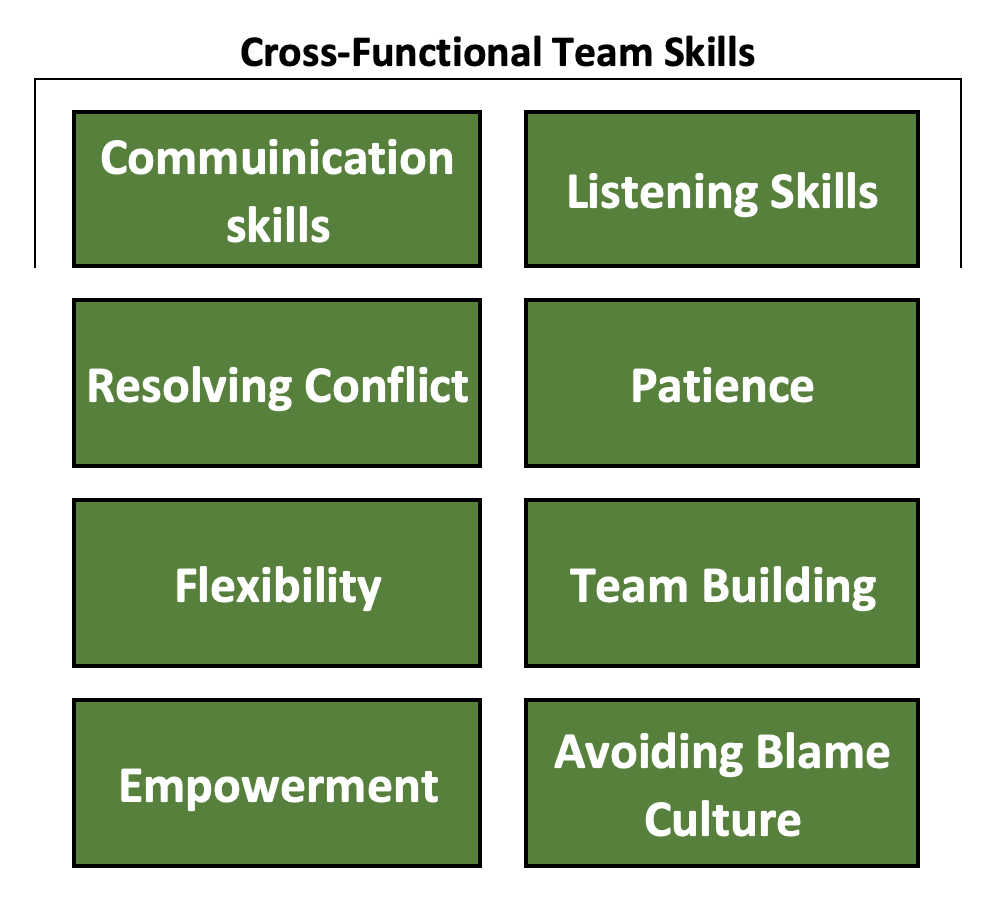One of the critical questions businesses face is how people & teams should work together.

Many organizations utilize a traditional functional-based silo model, but by utilizing cross-functional teams, organizations can equip themselves to tackle complex and difficult challenges.
Leadership within these cross-functional teams requires a variety of skills, which include:
- Communication
- Planning
- Listening
- Conflict resolution
- Team Building
In this article, we’ll be covering the concept of cross-functional team leadership. We’ll be covering:
- What is a Cross-Functional Team
- Cross Functional Team Leadership
- Leadership skills in cross-functional teams
- Planning & Organizational Skills
- Communication skills
- Listening
- Conflict Resolution
- Understanding & Patience
- Flexibility
- Team Building
- Empowerment
- Avoiding Blame Culture
- Differences between Departmental teams & Cross-functional teams
- Implementing a cross-functional team
- Benefits of Cross Functional Teams
- Problems with Cross-Functional teams
What is a cross-functional team?
Let’s start by asking ourselves what a cross-functional team is:
- A cross-functional team is a group of people that come together from different functional areas (e.g., Sales, Engineering, Design, Marketing, Finance) to achieve an objective or goal. This organizational structure might be temporary or permanent.
- A functional team is a group of people who work within a functional discipline within a hierarchical management structure, such as sales, engineering or procurement.
A cross-functional team typically has the following characteristics.
- The team comes from various functional areas.
- The team may consist of individuals with varying levels of seniority (e.g., Senior management, middle management, operators)
- The team has a shared goal.
- Each function contributing resources provides different skills and knowledge.
- The team may be permanent or “project” based.
- Several layers of management can exist in parallel.
- Functional governance (i.e., Engineering governance which occurs from outside the team)
- Team Governance, which happens inside the team.
- Cross-functional teams may be colocated or work separately in support of a goal.
- Cross-functional teams can include team members from outside the organization (customers, consultants, suppliers, etc.).
Cross Functional team leadership
The effectiveness of cross-functional teams (CTF’s) varies considerably from one organization to another.
While those within a cross-functional team may come from various departments within the business, leadership, and governance are still required.
Some of the leadership skills are common from managing silo-based functional teams. However, there is also a requirement for different skills (or approaching traditional skills with differing perspectives).
Cross-functional teams can be notoriously challenging to manage and sustain; understanding the issues that cause this, and providing strong leadership is a key step towards their success.
For those leading CFT’s, certain duties may be familiar (i.e., monitoring tasks, stakeholder management).
Leadership skills with cross-functional teams
Let’s take a look at some of the principle leadership skills required for managing cross-functional teams:

Planning & Organizational skills
From the very beginning, the cross-functional team requires a clear structure. The structure should answer:
- How will governance happen?
- How will tasking be managed?
- How will resource issues be dealt with etc.?
- What roles & responsibilities are required?
- How will the team manage quality?
Communication skills
Effective communication can make or break a cross-functional team and should be seen as the most critical enabler for your team’s success.
Cross-functional teams rely on clear communication even more so than traditional functional teams as they are often either dispersed through the organization or find themselves with multiple lines of governance.
By establishing a communications strategy, those leading cross-functional teams should look to use the most appropriate methods and tools that help enable the team.
Listening
Each team member will bring with them key skills and expertise. Leaders will need to listen carefully to colleagues, learning:
- How they will participate,
- What/How they will contribute
- What help they require
- What critical dependencies they have
- What issues and challenges require managing
Conflict resolution
One of the challenges of cross-functional teams is avoiding disharmony.
Having processes that can help resolve conflict will be key.
It’s only natural that functional groups band together within teams; this can sometimes breed discontent where decisions or priorities need to be made and sometimes go against them.
Being clear and open with people from the start about how conflicts will be resolved will help.
Understanding & patience
Cross-functional teams have different dynamics to functional teams, and people are likely to take time to adapt.
In a leadership role, you’ll need to demonstrate an understanding of the issues that are likely to emerge and show patience as people settle into their surroundings and ways of working.
Flexibility
Having various functions contribute from within a team can bring forward new ways of working, ideas, and innovations.
You will need to remain flexible, embrace change (where there is a benefit), and facilitate input from the team.
Team Building
There is likely to be a need for team building once the team has been established.
You may find yourself in a position where
- Much of the team have not worked together before.
- Functional awareness is limited.
- Processes are new, and interactions will be enhanced with positive relationships present.
Consider the mechanisms for team building early in the process.
Empowerment
Cross-functional teams benefit from high levels of empowerment.
Empowerment can be the glue that drives ownership and can facilitate quick decision making, innovation and change.
Consider how you will enable the team and what levels of empowerment can be provided early on in the team formation.
Avoiding Blame culture
One of the critical issues that often arise within cross-functional teams is that when things go wrong, blame culture becomes prevalent, with one functional area pointing the finger of blame at another.
This can be driven by various reasons:
- functional pride;
- distrust;
- gossip etc.
Blame culture within a cross-functional team can be an absolute killer. Consider this from the outset and instigate methods to deal with it.
Differences between Departmental teams & Cross-functional teams
There are various key differences between functionally led teams and cross-functional teams.
| Cross Functional Team | Functional Team |
| Executing a range of processes across various functions | Ownership of processes corresponding to a particular function |
| Various outputs which lead to a smaller number of objectives | Ownership/delivery of specific output |
| Empowered | Managed/Led |
| Higher levels of interference | Minimal interference |
| Often contains subject matter experts. | Diverse experience and knowledge amongst team members |
Implementing cross-functional teams
Once a need for a cross-functional team has been confirmed, the actual team will need to be established.

Leadership is likely to be involved heavily during this process, and it is likely that there will be a need for a level of experience in establishing and facilitating effective teams.
The process is likely to follow several stages;
- Goal identification
- Planning
- Team formation
- Establishing governance
- Tasking
- Monitoring
- Quality Assurance
- Delivery
These steps are likely to require various inputs:
- Having clear objectives
- Selecting the appropriate team (skills/experience)
- Establishing governance
- Having appropriate tools available
- Determining a communication plan
- Enabling creativity
- Having systems and processes that facilitate collaboration
- Having processes
- Encouraging an inclusive culture and one that avoids blame
- Measures that review successes and failures
- Systems that identify problems and issues early
- Utilizing continuous improvement
How to benefit from a cross-functional team
As we’ve seen, cross-functional teams can be a powerful tool within an organization, and there are crucial benefits that can be obtained:
- Innovation -Cross-functional teams tend to foster creative ideas by leveraging different approaches and experiences.
- Engagement – Boost engagement through empowerment and improved workplace dynamics.
- Collaborative culture – facilitating teams of different skills and experience to work alongside approaching a common goal
- Speed – CFT’s tend to reach goals quickly, reduce bottlenecks caused by resource issues or communication problems.
- Problem-solving – CFT’s can often solve key problems leveraging collaboration, experience, and perspectives within a team setting.
Problems with cross-functional teams
While there are many benefits, Cross-functional teams are, without doubt, challenging. All too often, the business is faced with some familiar difficulties:
- Communication – Too much, not enough, the wrong sort, not focused. Poor communication drives confusion and impacts the ability to hit goals.
- Functional favoritism/power – functional favoritism (e.g., Supply chain over Engineering), providing more power to one element of the team than another can lead to disharmony and poor effectiveness.
- Trust – Working alongside others from outside your own department requires trust with team-mates. Often there is a key reliance on different functional competencies where relationships and bonds have yet to be formed. Where trust has not formed (or is lost due to issues), this can slow progress.
- Lack of the right tools/enabling technology – Cross-functional teams often require different approaches to working, and attempting to get off the ground without the right tools can inhibit efficiency and effectiveness.
- No method of measuring success – while KPI’s are common in functional areas, measuring the success within a cross-functional team can be challenging. A lack of measures may drive complications when explaining benefits (often required to obtain resources or other forms of investment into the team).
Summary
Cross-functional teams can be a key enabler in helping organizations achieve goals.
There are key differences between traditional silo-based “functional teams” and cross-functional teams.
Leading these teams requires skills, some of which are likely to be new, in order for them to be effective.
Of these skills, “soft skills” like communication, patience and listening are of primary importance.
When establishing a CFT, sufficient time should be spent on goal identification, governance, and planning in order to get the most out of the team.
Many of the challenges faced with CTF’s are when enabling activity has not taken place, i.e., appropriate tools not provided, trust between participants not formed, communication is poor.
Understanding the difficulties met by cross-functional teams and then solving them is the key step in making them effective.
We’d love to hear some feedback on how you’re using cross-functional teams in your organization? Do you have some insights you might like to share? You can message us on Twitter or by using the comments section below.
This article is part of our Human Resources Guide.